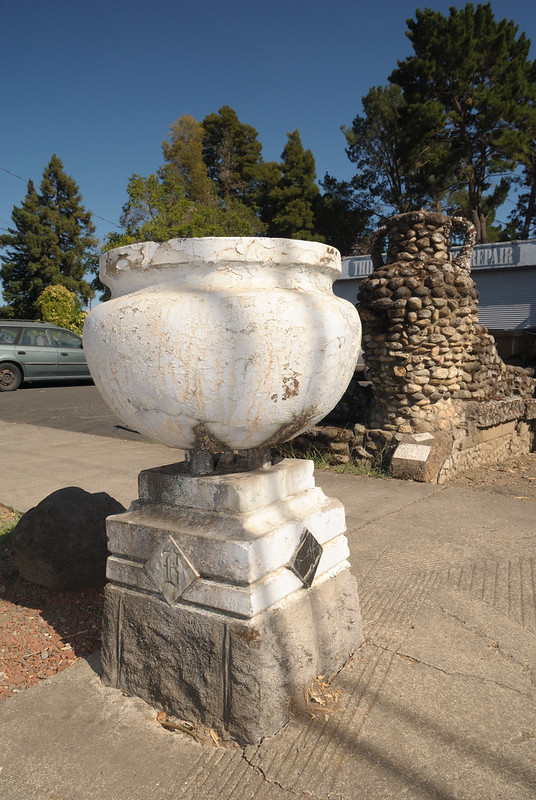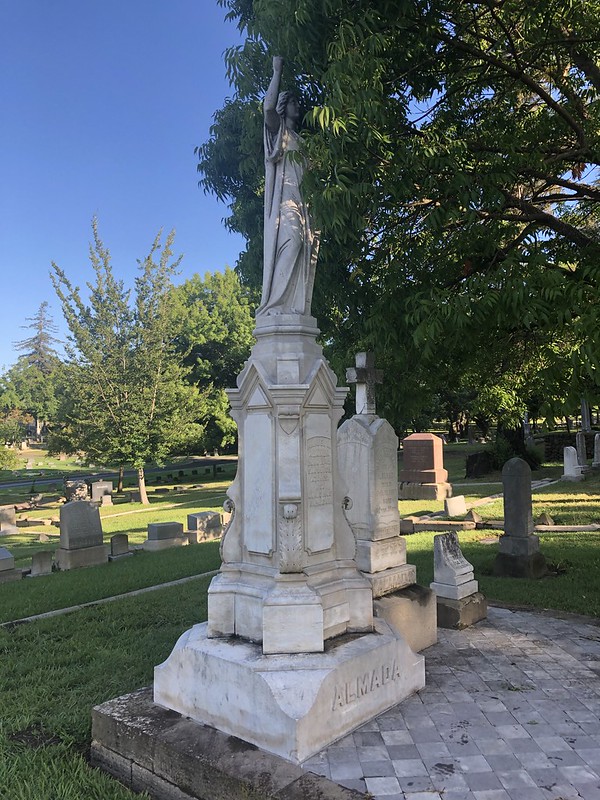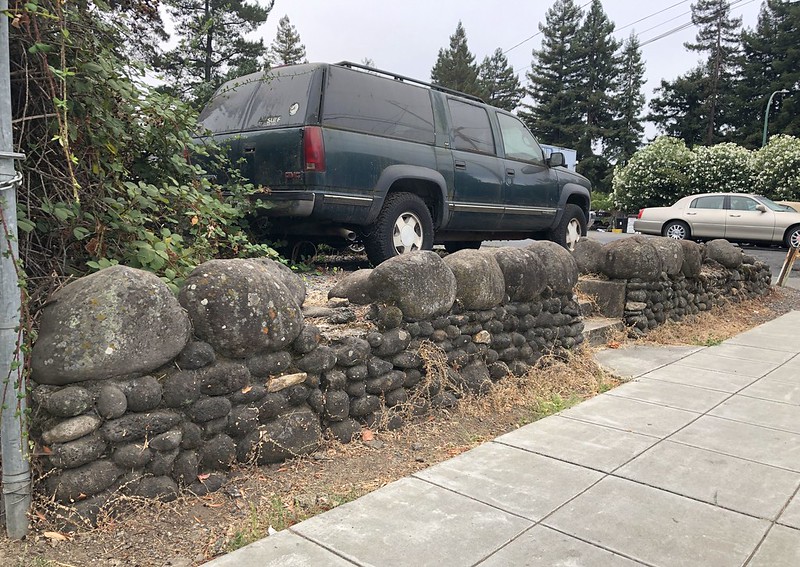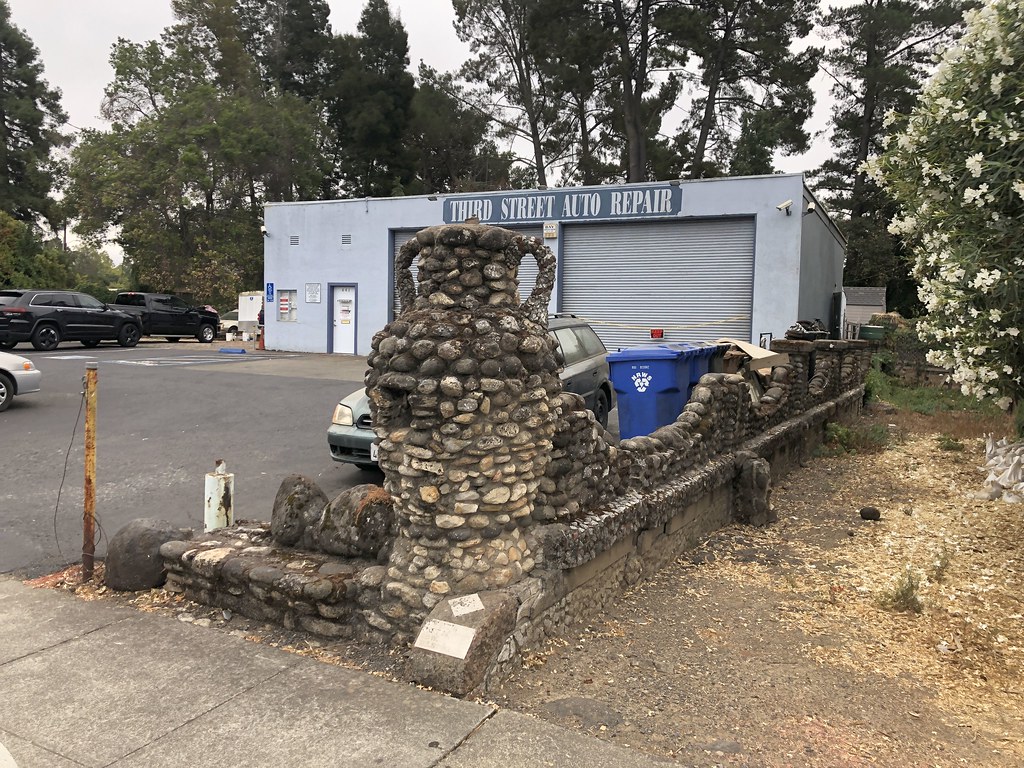Dedicated
to Nancy Brennan, the historian of Tulocay Cemetery, where many of Edward
Brown’s works of art are to be found.
Along
the edge of the property of Third Street Auto Repair, often partially obscured
by customers’ cars along the street, stands the remains of a cobblestone wall,
graced with a massive cobblestone urn on the west end. Across the sidewalk
(towards the street), two fine planters with the letter B ornately inscribed on
their base, but never filled with vegetation, complete the incongruous scene.
The inscription at the base of the urn offers some clues to the meaning of it
all” 19 DEEP SPRING 12” and “PUBLIC REST STATION EDW. BROWN DESIGNER” with the
“ROW” in Brown completely effaced and illegible.




The
property at 441 Third Street, right next to the north entrance to the Napa
Valley Expo, has long been the site of an auto repair shop. Vito J. Grossi
established Grossi’s Garage at the site after buying the property from the
Brown family in 1945. But when the Browns owned it, it was obviously something
different.
Edward
P. Brown was born in Benicia in 1875. His parents Lawrence and Mary (Cotter)
Brown had immigrated from Ireland in 1869, and his oldest sister was born on
the journey at sea. Soon after the family moved north. Tom Gregory’s 1912 History
of Solano and Napa Counties California says that they initially farmed in
Browns Valley, but the 1880 census shows the family living on Third Street, and
Lawrence is listed as a laborer. Edward’s brother John would later establish a
farm in Browns Valley, which perhaps explains the confusion.
It
was there on Third Street between Soscol and the Silverado Trail that Edward
Brown would establish his business in stone and concrete. This included rather pedestrian
work, like laying cement sidewalks. But it also included artistic work that
required exacting precision, such as memorial monuments. In fact, according to
Gregory, “Some of his work in the line of architectural sculpture may be seen
on the Spreckles Music Stand in Golden Gate Park, San Francisco, and the Herman
W. Hellman Building, Los Angeles” (p. 478).
But
one need not leave Napa to see the best of his work. That is featured at
Tulocay Cemetery in a monument he designed and built for Manuel A. Almada
(1842-1905), which Gregory wrote “is universally accepted as one of the most
beautiful specimens of monumental sculpture in the west” (p. 478) and was “the
finest monument in the cemetery” (p. 794). Apparently, he entered the design in
a competition and beat out 17 other entrants. Afterwards his newspaper
advertisements would describe him as “BUILDER OF THE M.A. Almada Monument. One
of the finest monuments of the same size and dimensions in the world.”


Manuel A. Almada Monument at Tulocay Cemetery
There
are undoubtedly many of Edward Brown’s vaults, monuments, and tablets in
Tulocay Cemetery that demonstrate his craftmanship. But without a surviving
ledger from his business to consult, most of them would be impossible to
identify. One exception is the Grand Army of the Republic Monument, as the
dedication of that monument merited a frontpage write-up in the Napa Daily
Journal that names Brown as its builder.


G.A.R. Monument at Tulocay Cemetery
As
for the rest station on Third Street . . . as the inscription indicates,
construction on it began in 1912—November of 1912, according to the only newspaper
article from the time that I have discovered yet. It was planned to have a
fountain and a stone bench. The cobblestone wall was to extend for 120 feet.


Obviously,
the construction would serve as an advertisement for Brown’s business, giving
examples of what he could do right along the route most Napans took to reach
Tulocay Cemetery. It would also serve as a rest stop for those making that
journey on foot.
For
more than 70 years now, it has been an easy-to-overlook relic that is slowly
disintegrating. I don’t know how many times I drove past it without taking
notice of it. It wasn’t until I scored a great parking spot on the street for
the Town and Country Fair and walked right past it with my daughter that I
finally took note of it.
With
a succession of auto repair shops occupying the spot since 1945, it has hardly
been the refreshing rest station that Edward Brown originally created. The
fountain and the stone bench are gone, and parts of the wall are crumbling.
It’s still there, though, after 107 years. But it might not be there much
longer.
While
many Napans have been concerned about the efforts of the Napa Valley Expo to evict
the Napa Valley Model Railroad Historical Society after 49 years of delighting
the public at their current location, Phase 4B of the Napa Valley Expo Master
Plan would also entail eliminating Third Street Auto and the remnants of Edward
Brown’s public rest station. According to that plan, both would be replaced by
parking—although the Register has been reporting that it is a new
livestock area that will be replacing the Quonsets of the railroad society (which
lies immediately behind the auto repair shop). But you can see the plans for
yourself here.
Edward
Brown never married and never had any children. But he left more permanent
reminders of himself in Napa after his death in 1941. They are easy to miss, but
they are also easy to notice and dismiss. I hope this history will help some
people to appreciate them more.

No comments:
Post a Comment